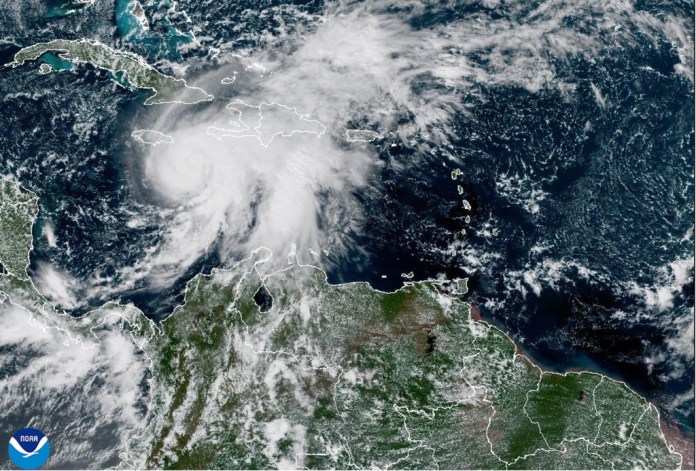“Melissa has become a hurricane with maximum sustained winds of 75 mph,” the U.S. National Hurricane Center said Saturday afternoon. “Rapid intensification is expected, and Melissa is forecast to become a major hurricane tomorrow.”
The slow-moving storm was expected to drop torrential rain, up to 25 inches (64 centimeters), on Jamaica, according to the U.S. National Hurricane Center. A similar forecast was issued for the southern regions of Haiti and the Dominican Republic through Monday. Life-threatening flooding and landslides were possible, with up to 35 inches (89 centimeters) of catastrophic rain across the Tiburon peninsula in southwestern Haiti, the center said.
The erratic and slow-moving storm has already killed at least three people in Haiti and a fourth person in the Dominican Republic, where another individual remains missing.
“Unfortunately for places along the projected path of this storm, it is increasingly dire,” Jamie Rhome, the center’s deputy director, said earlier on Saturday. He noted the storm will continue to move slowly for up to four days.
Melissa was located about 145 miles (230 kilometers) southeast of Kingston, Jamaica, and about 235 miles (380 kilometers) southwest of Port-au-Prince, Haiti. It had maximum sustained winds of 75 mph (120 kph) and was moving west-northwest at 1 mph (2 kph), according to the hurricane center.
A hurricane warning was in effect for Jamaica, while a hurricane watch remained in place for the southwestern peninsula of Haiti. Forecasters said the center of Melissa is expected to move near or over Jamaica early next week.
Melissa was expected to become a major hurricane by Sunday and possibly reach Category 4 status by early Monday, U.S. forecasters added. The storm is also forecast to hit eastern Cuba early Wednesday, where up to 12 inches (30 centimeters) of rain could fall in some areas.
Authorities in Jamaica warned that all airports would close within 24 hours once a hurricane warning was issued. More than 650 shelters were activated across the island. Officials stated that warehouses were well-stocked, with thousands of food packages prepositioned for quick distribution if needed.
“I urge Jamaicans to take this weather threat seriously,” said Jamaican Prime Minister Andrew Holness. “Take all measures to protect yourself.”
The hurricane center confirmed the risks in a key message Saturday afternoon, emphasizing the urgency: “Jamaica prep should be completed today. Melissa’s slow motion brings multi-day damaging winds plus heavy rainfall, catastrophic flash flooding, landslides, damage, long-duration power communication outages, isolation.”
Haitian authorities reported that three people had died as a consequence of the hurricane and another five were injured due to a collapsed wall. There were also reports of rising river levels, flooding, and a bridge destroyed due to breached riverbanks in Sainte-Suzanne, in the northeast.
“The storm is causing a lot of concern with the way it’s moving,” said Ronald Délice, a Haitian department director of civil protection, as local authorities organized lines to distribute food kits. However, many residents remain reluctant to leave their homes.
In the Dominican Republic, the storm has damaged nearly 200 homes and knocked out water supply systems, affecting more than half a million customers. It also downed trees and traffic lights, unleashed several small landslides, and left more than two dozen communities isolated by floodwaters.
The Bahamas Department of Meteorology warned that Melissa could bring tropical storm or hurricane conditions to islands in the Southeast and Central Bahamas and the Turks and Caicos Islands by early next week.
Melissa is the 13th named storm of the Atlantic hurricane season, which runs from June 1 to Nov. 30. The U.S. National Oceanic and Atmospheric Administration had predicted an above-normal season, with 13 to 18 named storms expected.
https://www.washingtonexaminer.com/news/3864164/storm-melissa-hurricane-catastrophic-flooding-northern-caribbean/


